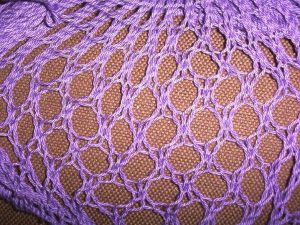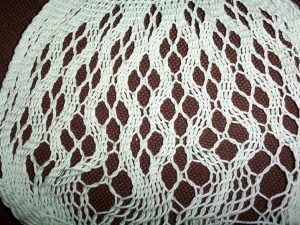This newsletter is transcribed from the Fibre Guild’s old website.
Newsletter for Twelfth Night A.S. XXXVIII
From The Editor
Hello everybody!
As this reaches you I will be about to make another interstate move, this time to the fair Barony of Politarchopolis. I look forward to meeting new people in the local SCA groups, and particularly to being just a hop, skip and jump from the Crossroads site for Rowany Festival!
A hot topic for discussion at Twelfth Night will be how we want to do gradings and rankings for the guild. Following the meeting some notes on proposed system will be published, and then everyone can have input into what we decide.
Please send me some articles, book reviews or pictures of your work!!! We would all love to be able to see the great stuff that other people are doing, and this newsletter is your chance to share your work with other people who are passionate about fibre arts. While your family and friends may find your obsession with bits of fluff and string kind of strange, here you have an audience of people with similar strange obsessions.
Thanks to the efforts of Mistress Acacia and Lady Gwennie and the generosity of Master Del, the Fibre guild now has a website. Again, this is your chance to share you work and interests with others. This website can be a valuable resource for people in isolated areas, and we should all think about contributing articles, patterns or photographs of work.
Rohese
Some of my Sprang!
To encourage others to send in pictures of their work, here’s some of mine! I recently started learning how to do sprang, and I was pleasantly surprised with how easy it is once you get started! Sprang is a weftless weaving technique, where you wind a warp between two parallel sticks, and then twist and cross the threads of the warp. Here are some pictures of some of the patterns I have tried.
 This pattern is from page 147 of “The Techniques of Sprang” by Peter Collingwood. The design is from a Coptic sprang cap.
This pattern is from page 147 of “The Techniques of Sprang” by Peter Collingwood. The design is from a Coptic sprang cap.
 I graphed this design and drafted the pattern myself! It is based on a design seen on a Coptic sprang hairnet.
I graphed this design and drafted the pattern myself! It is based on a design seen on a Coptic sprang hairnet.
Egyptian Knitted Pouches
There are a relatively large number of knitted fragments surviving from Egypt in the medieval period. They are all knitted in the round (knitted as a tube on multiple double pointed needles). The gauge is between 10 and 20 stitches per inch. Surviving examples are made from either wool or cotton, although one example is knitted from coloured wool and from ecru cotton.
Several of these surviving pieces are pouches which are thought to be either coin purses or possibly belt ends. The surviving pieces are long narrow tubes which are closed at one end (although one piece is fragmented at both ends). The pouch shown on the left has several different designs knitted into it, and was used as the inspiration for this pattern.
I decided to write a pattern for one as a sampler and introduction to Egyptian knitting. This pouch will start at the bottom and has a shaped bottom, to introduce people to making toe-up stockings. Then there are several pattern bands, including some with kufic script, so that people can learn how to read graphs and do stranded knitting evenly. Don’t worry if you make any mistakes – a surviving piece of knitting has “typos” in the knitting of the word “Allah”, so mistakes are period!
Materials:
- fairly fine wool or cotton in two different colours,
- set of 4 double pointed knitting needles,
- scissors (optional),
- tapestry needle (optional).
Gauge:
The gauge is not really important, as variations will just give a smaller or larger pouch.
Pattern:
Starting this project is the hardest part, so don’t worry if you find it a bit awkward. The first few rows are hard because it feels like you are trying to knit with a spider. You may find it easier to rest your knitting on a flat surface while you knit the first few rows.
Start by casting on 7 stitches. Put 2 stitches on the first two needles and 3 on the third. Then join into a circle by knitting the first and last stitches together. Make sure you don’t twist the knitting or you will make a moebius strip!
- Knit 1 row firmly.
- Knit 1, inc 1 (6x) (Use whatever type of increase you prefer. If you use a knit in back of stitch inc, you’ll need to do this every stitch).
- Knit 1 row.
- Knit 2, inc 1 (6x).
- Knit 1 row.
- Knit 3, inc 1 (6x).
- Knit 1 row. Now it should be getting easier!
- Knit 4, inc 1 (6x).
- Knit 1 row.
- Knit 5, inc 1 (6x).
- Knit 1 row.
- Knit 6, inc 1 (6x).
- Knit 1 row.
- Knit 7, inc 1 (6x). You should now have 48 stitches, 16 on each needle. If you want your pouch to be wider in diameter, just continue increasing a bit longer.
-
Knit several plain rows. Now knit one or more pattern sections. I’ve given you some graphs of designs, so that you can choose your own. These pattern graphs are from “A History of Handknitting”. Generally graphs are read by starting at the bottom right hand corner and reading across to the left. Because you are knitting in the round, start reading every line of the graph at the same side. Work several narrow pattern bands, or one wide band. When doing stranded knitting with two colours, always carry your main colour (white in this case) over the top and your second colour underneath. Try to keep your knitting even, especially at the corners between needles. You’ll notice loops of cotton forming on the inside of the work- these are called “floats”. If they are too loose or too long they’ll catch on things, but if they are too tight they’ll distort your knitting and it won’t be very stretchy (important for when you knit socks). If the floats are more than 4 or 5 stitches long, catch the cotton into the knitting every few stitches.
- When your pouch is the desired length, knit a few rows plain. Then you are going to work a row of eyelets to run your cord through.
- Knit 1 row of yarn forward, then knit 2 together (24x).
- Knit 1 row.
- Cast off. For a pouch you can cast off using a standard cast off as long as you keep it fairly loose, but if you later knit socks you should use a tubular cast off to give a stretchier edge.
- Sew your loose ends in. Make a twisted cord for the top. Make a tassel and sew it to the bottom (optional).
References
- “A History of Hand Knitting” by Richard Rutt. Batsford, 1987.
- “Tissus D’Egypte Temoins du Monde Arab VIIIc-XVc siecles: Collection Bouvier”, Societe Presence du livre, 1993.
Gifts to the Crown
We should start thinking about the guild’s end of reign gifts for Their Majesties soon! As Yolande has a particular interest in the Fibre Guild, possible gifts could include either finished items or unusual raw materials for her to spin.
Another approach is to have a box filled with random gifts from which appropriate gifts could then be given to Royalty. Suitable items could be cords, braids, homespun, knitted items, felted items, lengths of cloth or anything else pertaining to the activities of the guild.
Controversy Corner – Grading & Ranking Guidelines
The guildmasters have been working on coming up with some guidelines for grading pieces for rankings. Due to the problems inherent in being a very widely spread guild, we are attempting to make the grading guidelines very clear and easy to use, so that an item graded in Aneala will be graded the same as one in Ildhafen. This will give consistency all across Lochac.
In order for you to have your say about the gradings, the guidelines will be put onto our website and commentary will be asked for. Questions we’d like answered are:
- Do you think they are fair? Too hard? Too easy?
- Do you like a more structured style for the guidelines, or would you prefer a less formal style?
- How can you get items graded if you live a long way from other members? Are you happy to send items by post for grading?
Please discuss this topic in your local group, as well as on the mailing list.
Guild Masters
- Lady Morag Freyser (Politarchopolis)
- Mistress Marit the Wanderer (Agaricus)
- Mistress Margie of Glen More (Arrowreach)
- Mistress Miriam Galbraith (Stormhold)


